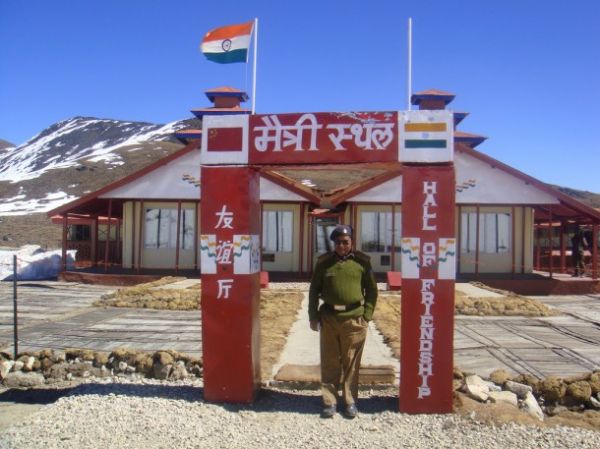


Photo: rajkumar1220
By Tao Duanfang (陶短房)
April 25, 2013
Commentary
Translated by Laura Lin
Original article: [Chinese]
On Apr 15th, India announced that an "intrusion" of around 50 Chinese military personnel had crossed onto the Indian side of the Line of Actual Control in Ladakh and set up a tent camp. The Indian military immediately responded with tit-for-tat camp of tents nearby. Thus the so-called “Tents Confrontation” standoff had begun.
The Ladakh region belongs to Indian-controlled Kashmir, and is known for both its very harsh weather and its historic place as part of the extended Silk Road. It’s also always been the source of a sovereignty dispute between China and India.
Although in recent years both sides have acknowledged the principle of “not breaking the status quo on the basis of the Line Of Actual Control” and the “peaceful settlement of disputes,” each country nonetheless holds very different views as to what the “Line of Actual Control” specifically refers to; in part because of the complex topography of the Ladakh region.
Since this Tents Confrontation started, the Indian-controlled Kashmir authority has raised the stakes, claiming that there had been a “Chinese invasion” and calling on Delhi to “fight back strongly.”
Ranjan Mathai, India’s Foreign Secretary, called in the Chinese ambassador to lodge a formal protest and demand an “immediate solution.” A. K. Anthony, the Indian Defense Minister, and the Chief of the Army Staff, General Bikram Singh, have both shown a tough stance, with the latter flying in to inspect the hotspot in person on Apr 24.
Since taking office in September, General Singh has spared no grandiloquence on his eastern flank, declaring that India “won’t allow the tragic failure of the 1962 Sino-India War to be repeated.” Others in New Delhi have also declared that India is capable of handling two fronts with Pakistan and China at the same time. All this leaves certain observers worried that India might use this incident to set off a military adventure and that the two most populated countries might end up having a large scale conflict.
The current confrontation coincides with frequent Sino-Japan disputes over the Diaoyu Islands. Meanwhile the Ya’an region adjacent to Tibet suffered a major earthquake so that regional military forces, equipment and attention has been diverted and constrained. It goes without saying that the waters around the South China Sea are not calm either.
Certain Chinese are convinced that India is either exploiting the disastrous situation China is facing, or is simply joining other “anti-China forces “as part of the “big conspiracy” aimed at containing China.
China and India’s border dispute is both longstanding and deep-rooted. With the halo of a “most vivid great power” and “Third World leader,” India was defeated by China in the 1962 war, a great blow to the nation's military image, and a lingering wound for the Indian government as well as its people. Despite progress in bilateral economic and trade relations in the past decades, as well as collaboration in various fields, the border issue and the war complex linger on.
After 14 rounds of bilateral negotiations, the two nations have yet to reach an agreement. Both sides still strongly distrust each other.
In recent years, India has spent an enormous amount of money in introducing advanced military hardware. From 2011 it also set forward a Sino-Indian border “five-year force-enhancing plan,” at a cost of $13 billion, reinforcing four divisions and two independent army brigades, a total of nearly 100,000 soldiers, as well as building high altitude airports, fortifications, roads, and adding light artillery adapted to the region’s terrain. The goal is to match China every step of the way.
High-stakes Crossroads
Though Ladakh is a barren region, it is located at the hub between Tibet, Xinjiang, India and Pakistan, and much of the new deployment is concentrated in this region. Not only is it in the front line of the Sino-Indian confrontation but is also key to the India-Pakistan, as well as a thorn in the side of Kashmir’s armed separatists. The Indians are extra sensitive to any sign of trouble in the region.
India has long been building up China as its imaginary enemy, even as it is so often distracted by having to deal with the old enemy, Pakistan, and with nonstop armed violence domestically.
The rapid rise of China’s national strength as well as military force is making it harder and harder for India to keep up. Both countries are very large with populations above one billion. Were a war to break out between the two, it would likely turn into a protracted conflicted. Even India’s war hawks are obliged to consider seriously whether they can afford conflict under such conditions.
Sounds of beating war drums include accusations of Chinese helicopters intruding into Indian airspace and intimidating Indian herders, as well as Kashmir’s local authority claims that “China is nibbling India’s territory inch by inch.”
India has spectacularly complex electoral politics. When elections come around, there are always politicians who incite voters’ nationalist sentiments in order to canvass votes.
But we should remember that, in the end, Indian authorities and military personnel much prefer negotiating to fighting. The bellicose attitude is mostly a way to create an environment that is advantageous for India in negotiations. Since the recent outbreak of the “Tents Confrontation,” the two parties have also been in close contact through numerous “flag talks” as well as hotline communication.
The Sino-Indian border issue is part of a bigger game at play. China and India are both big developing countries. Their border dispute makes it difficult to maintain decorum, but it is also difficult to be completely resolved.
The “Tent Confrontation” may well wind up like previous incidents. Having flared up unexpectedly from nowhere, it may also disappear without warning. Both countries will remain vigilant, in any case, because there is no overstating how much is at stake.
News in English via World Crunch (link)


